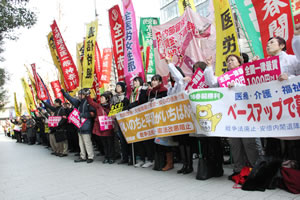On government survey on nation’s trade unions
Statement
By INOUE Hisashi
Secretary-General, National Confederation of Trade Unions (Zenroren)
December 24, 2015
 The Ministry of Health, Labor and Welfare on December 24 published the findings of the annual survey on the strength of Japanese trade unions for 2015. Although the union membership stood at 9,882,000, an increase of 33,000 or 0.3 percent from the previous year, the percentage of workers who are unionized was estimated at 17.4 percent, down 0.1 percentage points from the previous year. The union membership had declined since 2011. It remained fewer than 10,000,000 until 2014. It registered an increase in 2015 for the first time in four years. But the percentage of workers who are estimated to be union members has been in decline since the rate fell below 20 percent in 2003. The Ministry of Health, Labor and Welfare on December 24 published the findings of the annual survey on the strength of Japanese trade unions for 2015. Although the union membership stood at 9,882,000, an increase of 33,000 or 0.3 percent from the previous year, the percentage of workers who are unionized was estimated at 17.4 percent, down 0.1 percentage points from the previous year. The union membership had declined since 2011. It remained fewer than 10,000,000 until 2014. It registered an increase in 2015 for the first time in four years. But the percentage of workers who are estimated to be union members has been in decline since the rate fell below 20 percent in 2003.
The rise in the membership was mainly due to an increase in the number of women (66,000) and part-time workers (55,000) joining the union. The number of part-time workers for the first time reached the one million mark to 1,025,000. They account for 10.4 percent of all unionized workers. That’s up 0.5 percentage points from the previous year. Still, the unionization rate is 12.5 percent among women workers and 7.0 percent among part-time workers. Both fall behind the overall unionization rate of 17.4 percent.
The decline in estimated unionization rate is attributed to an increase of overall workforce. It should be noted that a decrease in the number of full-time regular workers is higher than an increase in the number of contingent workers, including part-timers and temps. A Ministry of Internal Affairs and Communications survey shows that the average number of workers was 63,510,000 in 2014. That’s up 400,000 from the previous year, registering an increase for two consecutive years. The number of contingent workers was 19,620,000 (up 560,000 from the previous year, registering an increase for the fifth straight years). A falling unionization rate is leading to the prevalence of “black companies”, power harassment and sexual harassment. We are firmly committed to doing even more to help organize unions, with emphasis on the effort to organize contingent workers.
Changes in union membership by sector are as follows: a 55,000 increase in wholesale and retail sale; a 37,000 increase in hotel and restaurant services; a 19,000 decrease in the public sector; an 11,000 decrease in education; and a 10,000 decrease in manufacturing. Membership has declined in the public sector due to privatization of public services, workforce cuts, and replacement of full-time regular workers with contingent workers. Union membership has declined in manufacturing due to more companies, mostly large ones, moving production sites to other countries, as well as streamlining within the country. Zenroren will further promote the efforts to win improvement of social services and education to increase public sector employees and to strengthen regulation on large global companies, help develop small- and medium-sized businesses, and create a regional economic cycle in society.
According to the ministry’s survey, the membership of the Japanese Trade Union Confederation (Rengo) stood at 6,891,000, up 42,000 from the previous year. Zenroren’s membership fell by 14,000 to 805,000. The National Council of Trade Unions (Zenrokyo) had 117,000 members, down 5,000. Zenroren has also members of unions which are not counted by the ministry’s survey. With these members added, Zenroren has a membership of 1,083,000. In Rengo, UA Zensen stood out with a membership increase of 70,000. Zenroren will further increase its effort to organize women and other contingent workers in conjunction with the work to achieve gender equality, a minimum wage increase, and equal treatment for contingent workers.
The midterm plan of Zenroren’s organizing effort that began in 2012 will close next year. We are determined to do our utmost to make a stride to increase its membership in 2016, the final year of the effort, toward achieving the target of a “1.5 million-strong Zenroren.” |

